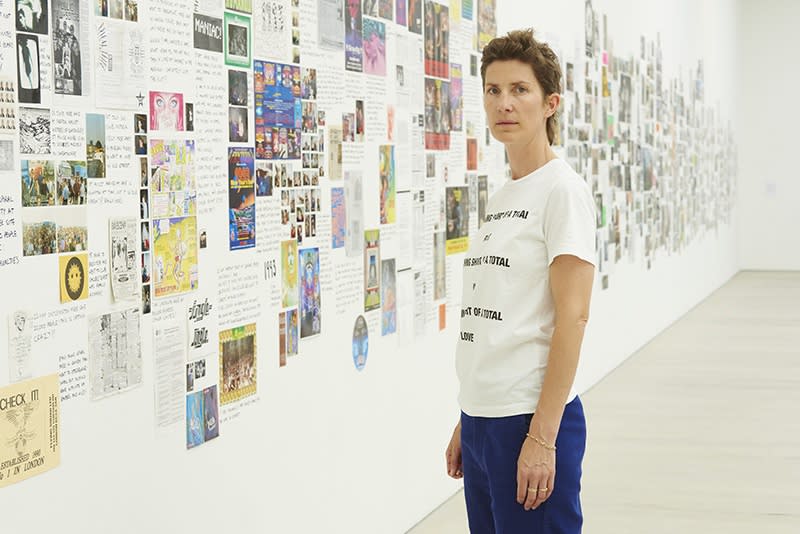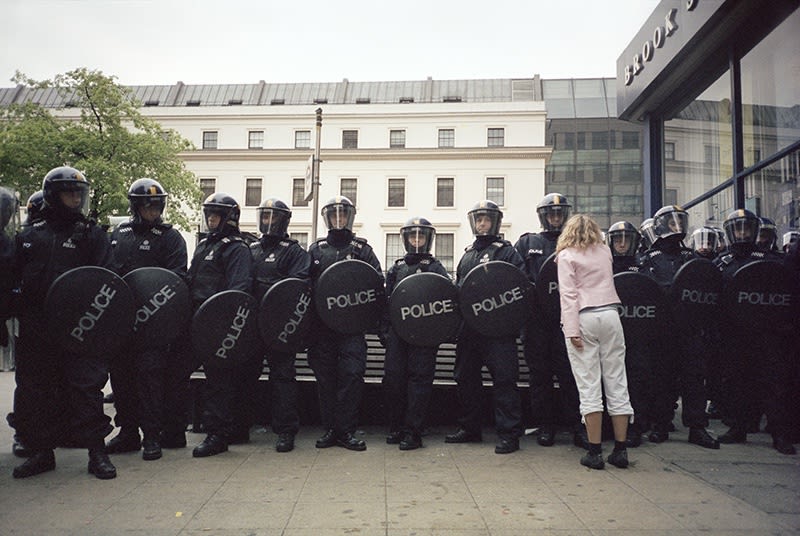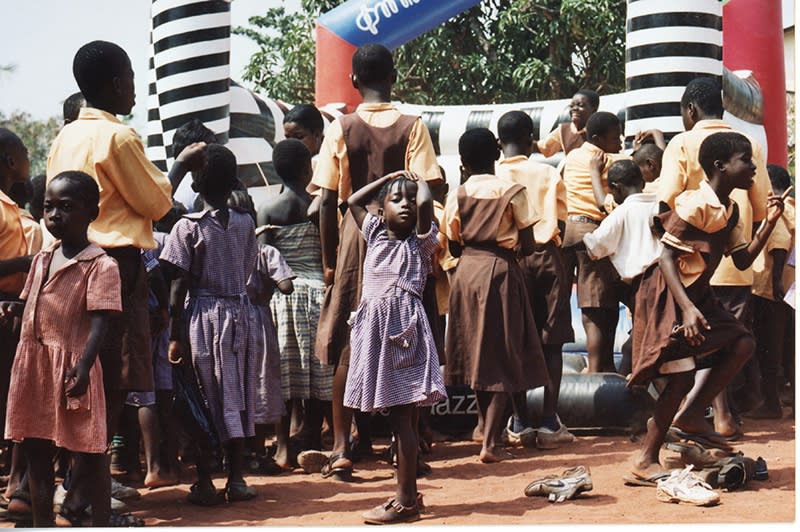
Vinca Petersen with A Life of Subversive Joy installation, Saatchi Gallery, 2019 © Gideon Hart.
My father was always photographing us as children and, as soon as I could hold a camera properly, he gave me a small Instamatic. I have the first roll of film I took at about seven years old. He would develop a lot of the photographs himself in makeshift darkrooms, so in my teens I used to join him and watch the magic of photography unfold in front of me. As with most teenagers, I was fascinated with my own image, and used to take portraits of myself in the mirror. Dad also used to make portraits of us using controlled set-ups and studio lights, but they were always so awkward and I never liked the results. I'm sure that's why I only use small cameras and try to make my subjects relaxed and almost unaware of the camera.
I have always been much more interested in the content than the image itself and feel it’s absolutely essential not to change or interrupt what is unfolding. I often take photos without holding the camera to my face, or mid-sentence, to preserve the authenticity of the moment. Many moments were too precious to interrupt – all the best photos were never taken.
Living an interesting life is the catalyst for my photography. I did not take photos to 'do anything' with them, but more to capture a sense of a moment I was living through. The quality of the image is not as important to me as the feel of it. Many of my images are blurred, imperfectly framed, under- or overexposed – they seek instead to embody the spirit of the unfolding scene. I believe they do this more wholly because of the lightness of touch of my technique.

Vinca Petersen, Pink Girl and Riot Cops, 2000. Courtesy the artist and Edel Assanti.
Another reason I took photos was to remember. When I left home and went to live in a squat in London and later in a truck on the road in Europe, life was so interesting and exciting that I thought I must capture this to remember it. I started to go to raves in and around London, but after the Criminal Justice Bill of 1994 sought to criminalise ravers and rave organisers, I decided to follow others out to Europe. I spent the next decade with various different nomadic groups and their sound systems, putting on illegal raves in the north of Europe in the summers, and heading south for the winter.
During this time, I continued to use small, simple cameras and brought the film back to England where I could develop them. Many of the people I lived with wanted copies of the prints, which was a complicated and expensive thing to do, so I set out to make 10 photo albums for each of the sound systems I had lived with. In the end, the cheapest way to replicate these images was to make them into a book (No System, Göttingen: Steidl, 1999). I was then able to give everyone a 'family photo album'. I worked on No System with Michael Mack before taking it to the publisher, Gerhard Steidl, who entered into the spirit of the book and helped me to keep it at a very low price affordable to anyone. He told me the book reminded him of his time printing the work of Andy Warhol and Joseph Beuys in New York. In 1999, I was the youngest female artist to work with Steidl.
The photograph River Conversation features in No System and in it we see a group of my friends from various different nomadic groups who had come together that summer to put on a huge Teknival, which is an illegal rave with many different sound systems playing music over many days. This photo is of us after taking some time out down at a local river in Millau, France. We were talking about where to go next and what our plans were to put on more free raves over the summer.
As well as photos, I kept pieces of writing, flyers, drawings and other ephemera from the time. I have never been a hoarder, especially moving around all the time, but I always kept this ephemera. It felt so of-the-moment and I had an instinct it would interest me in the future. More recently, when given the opportunity to fill a large space at the V&A Dundee, I decided to respond to all the interest in my story so far and created a 23-metre long installation; A Life of Subversive Joy (2019) contains over 800 photos and pieces of ephemera from the last 40 years.
After leaving life on the road, and giving birth to my son, I had time to step back and explore what else captured my interest. I did a Fine Art degree and discovered the work of Joseph Beuys and his concept of Social Sculpture. In response to this, I formed the Future Youth Project (FYP), which takes people on 'physical and emotional journeys'. I drove a bus full of FYP collaborators to Ukraine and Romania many times to take part in projects out there. In South Eastern Ukraine, we found a group of men and boys with disabilities, who had been left with only basic care and nothing to do all day, languishing in a state run institution out there. We set up a classroom for them and now the men have learnt to paint, sing, embroider and in some cases read and write. FYP is a social sculpture based on reciprocal giving – everyone gains. I have many photos from these journeys, but haven't shown them publicly yet.
I am still exploring earlier parts of my archive and have published two further books, Future Fantasy (2017) and Deuce and a Quarter (2018). Future Fantasy contains earlier work than No System does – the period in time between leaving school and travelling out to Europe. With collages from Ben Freeman and my photos and diary notes, the book explores the duality of my life as a young woman earning a living as a model whilst living in squats in London and discovering the rave scene. The final image is of me in my first live-in truck, about to head out to Europe. Deuce and a Quarter tells the story of four women on a road trip across Texas, and down into Mexico, in the late ‘90s. As with all my books, it seeks the joy and excitement of the adventure and, in this case, the magic of the female gaze.
Another body of work based around joy and adventure is Africa Laughter Aid (2004). This was a combination of photos, film footage, a giant inflatable and a 10,000 word account formed during a journey I took with the father of my child, before Archie was born. We wanted to appease our travelling bug to be able to settle for long enough to bring up a child, so we decided to drive overland across West Africa. In the spirit of 'giving back', and getting involved with people and places along the way, I decided we should take an inexhaustible gift in the form of a bouncy castle. It was very well received by children in Morocco, Western Sahara, Mauritania, Senegal, Mali, Gambia, Burkina Faso and Ghana!

Vinca Petersen, FYP Laughter Aid, Ghana, 2003. Courtesy the artist and Edel Assanti.
Currently, I am resident in the Northern Gallery for Contemporary Art in Sunderland for my exhibition and 5 actions called Make Social Honey: A Collective Search for Joy (29 January – 2 May 2022). This summer, I will be working on a show with Edel Assanti and, in the future, plan a show with the Martin Parr Foundation, where the original prints and maquettes of No System are archived.

